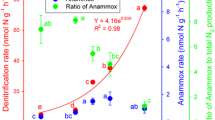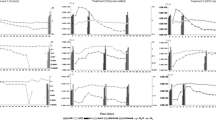Summary
The effect of increasing oxygen concentrations (0, 5, 10 and 20 Vol% O2) on total denitrification and N20 release was studied in model experiments using a neutral pH loamy soil relatively rich in easily decomposable organic matter and supplied with nitrate (300 μg nitrate N/g dry soil). The sterilized soil was inoculated with three different denitrifying bacteria (Bacillus licheniformis,Aeromonas “denitrificans” andAzospirillum lipoferum) and incubated (80% WHC, 30°C). The gas volume was analysed for O2, CO2, N2O, NO and N2 by gas chromatography and the soil investigated for changes in ammonium, nitrite, nitrate, pH, total N and C as well as water-extractable C. WithB. licheniformis andAeromonas “denitrificans” total denitrification increased remarkably with increasing pO2 as the result of intensified mineralization.Azospirillum lipoferum, however, showed the highest activity at 5 vol% O2. WithB. licheniformis N2O was released only in anaerobic conditions and at 5 Vol% O2 (maximum) or 10 Vol% 02, but not at 20 Vol%, whereasAeromonas “denitrificans” produced N2O only in the presence of He gas (maximum) or at 5 Vol% O2. In contrast to these bacteria, N2O production withAzospirillum lipoferum was restricted to 10 Vol% O2 (maximum) and to 20 Vol% 02, with some traces at 5 vol% O2. With a certain set of conditions, total denitrification and N2O formation seem to be governed by the mineralization rate of the organisms in question. The increased demand for electron acceptors by a high turnover rate rather than the presence of anaerobic conditions seems to have determined the rate of denitrification.
Similar content being viewed by others
References
Balks R, Reekers I (1965) Bestimmung des Nitrats und Ammoniakstickstoffs im Boden. Landwirtsch Forsch 8:7–13
Bremner JM (1965) Inorganic forms of nitrogen. In: Black CA (ed) Methods of soil analysis, part 2. American Society of Agronomy, Madison, Wisconsin
Burford JR, Bremner JM (1975) Relationship between the denitrification capacities of soils and total water-soluble readily decomposable soil organic matter. Soil Biol Biochem 7:389–394
Burth I, Ottow JCG (1983) Influence of pH on the production of NO2 and N2 by different denitrifying bacteria andFusarium solani. Ecol Bull (Stockholm) 35:207–215
Cho CM, Mills JG (1979) Kinetic formulation of denitrification process in soil. Can J Soil Sci 59:249–257
Delwiche CC, Bryan BA (1976) De nitrification. Ann Rev Microbiol 30:241–262
Doner HF, Volz MG, McLaren AD (1974) Column studies of denitrification in soil. Soil Biol Biochem 6:341–346
El Demerdash ME, Ottow JCG (1983) Einfluß einer hohen Nitratdungung auf Kinetik und Gas-Zusammensetzung der Denitrifikation in unterschiedlichen Boden. Z Pflanzenernaehr Bodenkd 146:138–150
Fabig W, Ottow JCG, Müller F (1958) Mineralisation von C14-markiertem Benzoat mit Nitrat als Wasserstoff-Akzeptor unter vollständig anaeroben Bedingungen Bowie bei vermindertem Sauerstoffpartialdruck. Landwirtsch Forsch SII 35:441–453
Fabig W, Ottow JCG, Muffler F (1980) Failure of denitrifying bacteria to utilize benzonic acid under anaerobic conditions with nitrate as the only terminal electron acceptor. Europ J Applied Microbiol Biotechnol 9:133–135
Firestone MK, Firestone RT, Tiedje JM (1980) Nitrous oxide from soil dentrification:Factors controlling its its biological production.
Knowles R (1981) Denitrification. Soil Biochemistry, vol. 5. In: Paul EA, Ladd JN (eds) Marcel Dekker, New York, pp 323–369
Malinowsky P, Ottow JCG (1984) Conditions of nitrogen oxide release (denitrification) by fungi in batch cultures. Proc Third Ear Congr Biotechnol, Munich, Verlag Chemie, Weinheim FRG, vol 3, pp 17–21
Moretti E, Leofanti G, Andreazza D, Giordano N (1974) Gas chromatographic separation of effluent from ammonia oxidation reaction: O2, N2, N2O, NH3, and HO. J Gas Chrom Sci 12:64–66
Munch JC, Ottow JCG (1984) Composition of denitrification gases (N2/N2O/NO) from soil as affected by the denitrifying microflora. In: Udluft P, Merkel B, Prösl KH (eds) Proc Internat Symp Munich. Recent investigations in the zone of aeration (RIZA), Copy Shop Darmstadt, FRG, vol 2, pp 437–443
Nicholas DJD, Nason A (1957) Determination of nitrate and nitrite. In: Colowick SP, Kaplan NO (eds) Methods in enzymology, vol. 3. Academic Press, New York pp 981–984
Ottow JCG, Fabig W (1985) Influence of oxygen aeration on denitrification and redox level in batch cultures of various bacteria. Proc. 6th Internat. Symp. Environm. Biogeochem., 1983, Santa Fe, USA (in press)
Robertson LA, Kuenen JG (1984) Aerobic denitrification — old wine in new bottles? Antonie van Leeuwenhoek 50:525–544
Rosswall T (1980) Microbiological nitrous-oxide production: Implications for the global nitrogen cycle. In:Trudinger PA, Walter MR, Ralph BJ (eds) Biogeochemistry of ancient and modern environments. Springer Verlag, Berlin, Heidelberg, New York, pp 267–278
Schlichting E, Blume HP (1966) Bodenkundliches Praktikum. Parey, Hamburg
Schmider F, Ottow JCG (1985) Charakterisierung der denitrifizierenden Mikroflora in den verschiedenen Reinigungsstufen einer biologischen Klaranlage. Arch Hydrobiol (in press)
Thauer RK, Jungermann K, Decker K (1977) Energy conservation in chemotrophic anaerobic bacteria. Bacteriol Rev 41:100–180
Wilhite WF, Hollis OL (1968) The use of porous-polymer beads for analysis of the martian atmosphere. J Gas Chrom 6:84–88
Author information
Authors and Affiliations
Rights and permissions
About this article
Cite this article
Abou Seada, M.N.I., Ottow, J.C.G. Effect of increasing oxygen concentration on total denitrification and nitrous oxide release from soil by different bacteria. Biol Fert Soils 1, 31–38 (1985). https://doi.org/10.1007/BF00710968
Received:
Issue Date:
DOI: https://doi.org/10.1007/BF00710968




